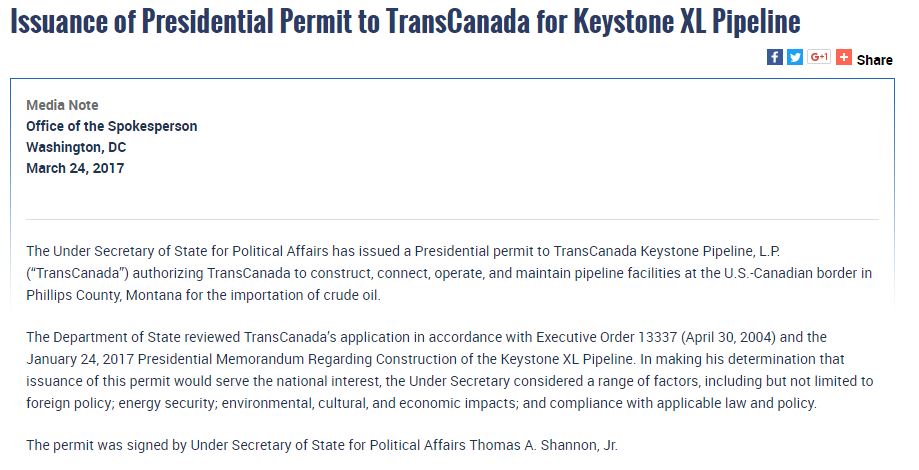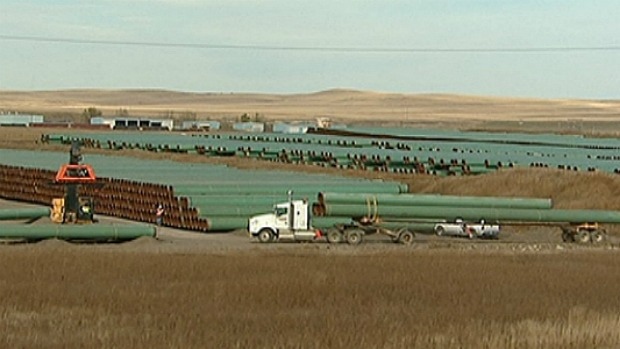Mar. 24, 2017: TransCanada receives Presidential Permit to move forward with Keystone XL pipeline construction
After enduring more than eight years of permitting hell, topped at the seven-year mark with a flat rejection by President Obama’s State Department, today TransCanada (ticker: TRP) finally has a U.S. Presidential permit in hand for the Keystone XL pipeline.

The Presidential permit officially greenlights the Canadian midstream company, after it receives remaining local and state permits, to begin building the 1,160 miles of 36-inch pipe that traverses the two nations’ joint border. Used to dealing with a historically pro-energy partner in the U.S., by 2015 TransCanada had already invested more than $2 billion including taking delivery of most of the pipe and pumps—that will eventually transport 830,000 barrels of oil per day from Alberta to the U.S. Gulf coast refineries.
“This is a significant milestone for the Keystone XL project,” said Russ Girling, TransCanada’s president and chief executive officer.
“We greatly appreciate President Trump’s administration for reviewing and approving this important initiative and we look forward to working with them as we continue to invest in and strengthen North America’s energy infrastructure,” Girling said in a statement.
TransCanada described Keystone XL as “an important piece of TransCanada’s comprehensive U.S. growth portfolio driving an investment of more than US$15 billion in liquids and natural gas projects that will create thousands of well-paying jobs and generate substantial economic benefits across the U.S.”
TransCanada said it will continue to engage key stakeholders and neighbors throughout Nebraska, Montana and South Dakota to obtain the necessary permits and approvals to advance this project to construction.
Ends court challenge
In conjunction, TransCanada has discontinued its claim under Chapter 11 of the North American Free Trade Agreement (NAFTA) and will end its U.S. Constitutional challenge.

TransCanada already operates 56,900 miles of natural gas pipelines in North America along with 653 Bcf of natural gas storage capacity. Its current liquids pipeline system extends over 2,700 miles.
Approval of the Keystone XL oil pipeline will not undermine the United States’ leadership on climate change, and to claim otherwise is “not fair,” the State Department said yesterday.
“This administration is conducting a review of climate change policy, but our record on this issue speaks for itself,” acting State Department spokesman Mark Toner told reporters. “I think we have been a leader in addressing climate change globally, regardless of this decision that’s made with respect to this Keystone application.”
“We’re looking at previous data and other factors,” he said. “I can’t speak to any of the conclusions that this new review has discovered. … We’re looking at it with fresh eyes and trying to see if there are any new factors to consider,” Toner said.
Calling KXL an “incredible pipeline,” Trump signed the presidential permit for the pipeline to cross the U.S.-Canada border. At his side were TransCanada CEO Russell Girling, Energy Secretary Rick Perry and the heads of labor unions, E&E reported.
“Keystone, finished. They’re going to start construction when?” Trump asked, turning to Girling, who quickly noted that the project still needs the Nebraska permit.

What’s next for Keystone XL?
In March 2015, Oil & Gas 360® interviewed Corey Goulet, President of Keystone Projects for TransCanada and boss of the Keystone XL project.
As President, Keystone Projects, Goulet has overall accountability for the development and implementation of all phases of the Keystone Pipeline including securing land and permits, engineering, procurement, construction, commissioning, start-up and testing. Highlights of that interview are republished below.
OIL & GAS 360®: Could you talk about the Keystone project history—starting with the first Keystone pipeline – when it was built, the route, and the overall scope of the project.

COREY GOULET: The first Keystone pipeline was completed in 2010. It goes from Hardisty, Alberta, across Saskatchewan and Manitoba to a point west of Winnepeg. From there it goes south through North Dakota and South Dakota to Steele City, Nebraska. It originally went east to Patoka, Illinois, to service refineries in that area. The southward extension of the Keystone from Steele City to Cushing, Oklahoma, was completed in 2011. Then in 2014 we completed the very southern part, the Gulf Coast pipeline. That portion goes from Cushing to Beaumont/Port Arthur, Texas. Now we’re finishing a small 50-mile pipeline that comes off the Gulf Coast pipeline to Houston tank storage. The completed Keystone pipeline will be able to transport about 830,000 barrels of oil per day (BOPD) to U.S. refineries.
Keystone XL portion of the Keystone pipeline system is represented by the blue dashed line. The portions represented by solid lines are completed.
OAG360: Now let’s move to the Keystone XL pipeline. What is the difference in the two?
COREY GOULET: The Keystone XL will start at Hardisty, Alberta. The idea is to cut the hypotenuse of the triangle. If you look at it on the map, it’s a straight line all the way to Steele City, through the Williston Basin. It’s 1,200 miles long and we now estimate the investment in the Keystone XL will be about $8 billion. It’ll take two years to construct and six months to fill and bring it into what we call “fully in service.” Three hundred miles of it are in Canada and 900 miles are in the U.S. When it’s done, you’ll end up with a pipeline system moving oil from Hardisty, Alberta, adding crude from the Bakken oil fields in the U.S., and delivering it to the Gulf coast for refining into gasoline, diesel fuel, jet fuel and other products that we use.
OAG360: Politics aside, if the Keystone XL legislation that Congress passed were to be signed into law by the president tomorrow, how would you proceed? What are the next steps to get the pipeline built?
COREY GOULET: First, we need to get the ‘okay’ from the U.S. government. The U.S. State Department delayed the national interest determination period last year. So that needs to be finalized. We received a permit to start work in South Dakota four years ago, but South Dakota has a ‘four year clause’. After four years they will have to confirm that the conditions of our permit have not changed. But we believe that is in good shape because events in the past four years have actually improved the conditions of the permit.
At the time we got our permit from South Dakota, the 59 conditions proposed by the U.S. Department of Transportation Pipeline and Hazardous Materials Safety Administration weren’t yet part of the agreement; now that we have voluntarily adopted them, the result is that Keystone XL will be the safest pipeline ever built on U.S. soil. Second, we added an onramp in the Bakken to transport U.S. Bakken crude oil to market. Other improvements come in the form of increased taxes we pay the state of South Dakota.
Keystone XL – Quick Facts
329 miles (529 km) in Canada (Hardisty, Alta., to Monchy, Sask.)
840 miles (1,351 km) in the United States (Phillips County, Mont. to Steele City, Neb.)
36-inch diameter pipeline
Capacity of 830,000 barrels per day
We need to complete the judicial process in the state of Nebraska. In a case that went to the Nebraska Supreme Court, the court ruled the three landowners did not have standing, so our route held up. But since then two more court cases have been brought. We voluntarily agreed to a stay of the eminent domain process, but this will likely go back to the Nebraska Supreme Court later this year, after which we can take away another question mark.
OAG360: How much investment of time and capital is needed to complete the Keystone XL?
COREY GOULET: We’ve invested about $2.5 billion so far: we’ve bought just about all the pipe and the pumps and motors. We’ve completed most of the engineering and we’ve spent six and a half years in the permitting process.
What’s left to do? Once we get the president’s signature and the state permits, we have to get approvals from the U.S. Army Corps of Engineers, the U.S. Fish and Wildlife Service and hundreds of county permits.
After that we can start construction and that will be about two years of work.
OAG360: Producers are moving the oil now using rail. There have been some derailments in the news. Are pipelines a safer way to transport oil?
COREY GOULET: We definitely think so. It’s safer and more cost effective, and the U.S. Department of State Final Supplemental Environmental Impact Statement put forth that the pipeline is less greenhouse gas intensive than transporting oil by rail or other options for transporting oil. The other options have 28%-42% more impact on greenhouse gases than the Keystone XL pipeline.
Producers are moving their oil now by rail. In 2008-2010, about 100,000 to 200,000 barrels of oil per day were moving by rail. But with the huge increase in production from the U.S. and Canada, by the end of 2015 each country will be moving about one million barrels of oil per day by rail—each. That’s double the planned capacity of the Keystone XL pipeline. If anything, the Keystone XL would reduce the greenhouse gas impact from the current transportation infrastructure. Even with the pipelines, rail still has a place in transporting oil shorter distances and transporting smaller volumes. Both have a place in the transporting of hydrocarbons, but for long distance/high volume, pipelines are the safest and least greenhouse gas intensive.
OAG360: When you attend community meetings and landowner meetings during the process of permitting a pipeline, what are the primary concerns and questions that you hear from the local people along the route?
COREY GOULET: I am glad you asked that question. It is very important to spend time with the communities that are directly involved. Often these big projects get politicized on a large national scale, but the local folks are the people who are the most affected.
Their first concern is safety. They want to make sure the pipeline follows a path that will have minimal impact on their community. They are glad we worked with the Department of State to include the 59 standards. These standards will make this the safest pipeline ever built in the U.S.
Another thing people are concerned about is protecting of the environment. They want to minimize the possibility of a spill.
The other thing they want to know is “what’s in it for us?” For one thing there are good jobs in the construction phase. It’s two years of work for a construction worker with overtime and benefits. That can add up to 10%-15% of someone’s career income in this single project. And there is the larger economic stimulus coming to the region as a whole, too. The State Department estimates 42,000 jobs in total will be created.
When we built the Gulf Coast portion of the project, you couldn’t find a local business owner who didn’t appreciate the infusion of capital to the local area. When we built the Gulf Coast project some of the car and truck dealerships saw a 25% increase in sales. Restaurants and grocery stores saw increases.
Probably the most important thing is the lasting legacy for those communities and the states. We expect to pay $50 million in taxes per year to the counties and states we cross. For some counties this will mean their tax revenues will double.
OAG360: How would you sum up the Keystone XL project?
COREY GOULET: The Keystone XL pipeline is really a choice about where Americans want to get their oil. About 45% of the crude oil used in the U.S. today is imported from other countries. It’s about switching supply from Venezuela, Nigeria and the Middle East to the U.S. and Canada. Our shippers want to transport their crude oil from the Bakken and Canada to the Gulf coast refining hub. With the Keystone XL , we will provide the infrastructure to do that.
It all comes down to: where do you want to get your oil?
Sept. 19, 2008 to Nov. 6, 2015 = 7 years of permitting, government delays and a flat rejection
The United States House of Representatives Energy & Commerce Committee’s Keystone XL timeline is reproduced here, as presented by Chairman Fred Upton:
September 19, 2008 – TransCanada submits an application to the U.S. Department of State to construct the Keystone XL pipeline, an extension of the existing Keystone pipeline.
2009 – Department of State conducts 20 scoping meetings in communities along the pipeline route and consults with federal and state agencies and Indian tribes.
April 16, 2010 – Department of State issues its Draft Environmental Impact Statement. It opens a 45-day comment period, which it extends for additional days.
Summer 2010 – Department of State hosts 21 public comment meetings in communities along the pipeline route. When the public comment period is extended, additional meetings are held. Nearly 1,800 verbal and written comments are received.
October 15, 2010 – Speaking to the Commonwealth Club of San Francisco, Secretary of State Hillary Clinton is asked about approval of the Keystone XL pipeline and she says, “we are inclined to do so.”
October 25, 2010 – The General Presidents of four international unions representing a total of 2.6 million workers send a letter to Secretary of State Hillary Clinton urging the Department of State to approve the Keystone XL pipeline project.
December 7, 2010 – Department of State hosts a government-to-government meeting for Indian tribes and other consulting parties.
January 2011 – TransCanada agrees to adopt 57 project-specific special conditions for design, construction, and operations of the Keystone XL pipeline. The conditions are developed by the Department of State and the Pipeline and Hazardous Materials Safety Administration; according to the Supplemental Environmental Impact Statement, these conditions would give the Keystone XL pipeline “a degree of safety over any other typically constructed domestic oil pipeline,” making it a truly state-of-the-art pipeline.
April 15, 2011 – Department of State issues a Supplemental Draft Environmental Impact Statement and opens another 45-day comment period. More than 280,000 comments are received.
July 25, 2011 – The Obama administration issues a Statement of Administration Policy calling legislation related to the Keystone XL pipeline unnecessary, declaring, “the Department of State has been working diligently to complete the permit decision process for the Keystone XL pipeline and has publicly committed to reaching a decision before December 31, 2011.”
July 26, 2011 – U.S. House of Representatives approves H.R. 1938, the North American-Made Energy Security Act. The bill, authored by Rep. Lee Terry (R-NE), requires a decision on the Keystone XL pipeline by November 1, 2011. The bill is approved with a strong bipartisan vote of 279-147.
August 26, 2011 – Department of State issues its Final Environmental Impact Statement and opens up a 90-day review period. The agency continues accepting public comments.
Fall 2011 – Department of State hosts public meetings in states along the pipeline route.
November 10, 2011 – President Obama announces that no decision on the Keystone XL pipeline will be made until after the 2012 election. A decision is expected in early 2013, after the administration identifies a new route for the pipeline.
November 10, 2011 – The president’s decision is widely attributed to political pressure exerted by environmentalist groups opposed to the pipeline. A statement from Terry O’Sullivan, General President of the Laborers’ International Union of North America, sums up the response: “Environmentalists formed a circle around the White House and within days the Obama administration chose to inflict a potentially fatal delay to a project that is not just a pipeline, but is a lifeline for thousands of desperate working men and women. The administration chose to support environmentalists over jobs – job-killers win, American workers lose.”
December 23, 2011 – Both the House and Senate unanimously approve – and President Obama signs into law – a bill requiring approval of the Keystone XL pipeline within 60 days unless the president determines the project does not serve the national interest.
January 18, 2012 – After over three years of review, President Obama formally rejects the pipeline’s Presidential Permit and asks TransCanada to reapply.
February 7, 2012 – The Energy and Commerce Committee approves H.R. 3548, the North American Energy Access Act. The bill, authored by Rep. Lee Terry (R-NE), removes the president’s authority over the pipeline’s permit and transfers it to the Federal Energy Regulatory Commission.
February 16, 2012 – U.S. House of Representatives approves the PIONEERS Act with language from Rep. Terry’s bill requiring swift approval of the pipeline.
March 8, 2012 – President Obama personally lobbies the Senate to kill an amendment calling for congressional approval of the Keystone XL pipeline. In spite of the president’s efforts, 11 Senate Democrats joined all voting Republicans in favor of the project.
March 22, 2012 – On a visit to Cushing, Oklahoma, President Obama takes undue credit for the southern leg of the pipeline from Cushing to the Gulf Coast, ignoring the fact that he rejected the only Keystone permit that requires his approval because it crosses our national boundary with Canada.
April 18, 2012 – House approves H.R. 4348, the Surface Transportation Extension Act of 2012, including language authored by Rep. Lee Terry (R-NE) taking the pipeline out of the president’s hands and requiring the Federal Energy Regulatory Commission to approve the permit within 30 days. The bill passed with veto-proof support by a vote of 293-127.
April 18, 2012 – TransCanada submits a reroute of the Keystone XL plan to the state of Nebraska for review.
May 4, 2012 – TransCanada reapplies to U.S. State Department for a Presidential Permit.
May 18, 2012 – House passes a Motion to Instruct Conferees on H.R. 4348 to insist on Title II of the House bill regarding approval of the Keystone XL Pipeline. The motion passed with a bipartisan vote of 261-152.
June 15, 2012 – State Department publishes Notice of Intent (NOI) to prepare a Supplemental EIS (SEIS) for the second Keystone XL Presidential Permit application.
January 22, 2013 – Nebraska Governor Dave Heineman gives approval of the proposed reroute of the pipeline through the Cornhusker State.
March 1, 2013 – The U.S. State Department issued its Supplemental Environmental Impact Statement for the Keystone XL Presidential Permit application, which includes the proposed new route through Nebraska. The SEIS findings are similar to the Department’s FEIS issued last August, which found the pipeline will have limited adverse environmental impacts.
March 15, 2013 – H.R. 3, the Northern Route Approval Act, is introduced in the House by Rep. Lee Terry (R-NE). The bill addresses all the permits necessary beyond just presidential approval and would limit litigation that could doom the project.
March 22, 2013 – U.S. Senate agrees to Sen. John Hoeven’s (R-ND) budget amendment urging approval of the Keystone XL pipeline by a vote of 62-37. 17 Democrats joined every Senate Republican voting in favor of the amendment, signaling future filibuster-proof support for legislation to build the pipeline using congressional authority.
April 17, 2013 – The Energy and Commerce Committee approves H.R. 3, the Northern Route Approval Act, by a vote of 30 to 18.
May 22, 2013 – House approves H.R. 3, the Northern Route Approval Act, with bipartisan support by a vote of 241 to 175.
January 31, 2014 – The U.S. State Department issued its Final Supplemental Environmental Impact Statement for the permit application, confirming the project is safe and will have limited environmental impacts. The report reflects that TransCanada has agreed to incorporate 59 special safety conditions recommended by PHMSA.
April 18, 2014 – The U.S. State Department announced it will delay the national interest determination period indefinitely, citing a need to wait until the Nebraska Supreme Court can rule over the route.
September 18, 2014 – House approves H.R. 2, the American Energy Solutions for Lower Costs and More American Jobs Act, a broad energy package that includes the language of H.R. 3.
November 14, 2014 – House approves H.R. 5682, a bill authored by Rep. Bill Cassidy (R-LA), which would approve the application for the Keystone XL pipeline.
January 9, 2015 – House approves H.R. 3, the Keystone XL Pipeline Act, authored by Rep. Kevin Cramer (R-ND), which would authorize construction of the project.
January 29, 2015 – Senate approves S.1, the Keystone XL Pipeline Approval Act.
February 11, 2015 – House approves S.1, the Keystone XL Pipeline Approval Act, sending the bill approving the pipeline to the president’s desk.
February 24, 2015 – President Obama vetoes S.1, the Keystone XL Pipeline Approval Act
November 6, 2015 – Obama administration / U.S. State Department reject TransCanada’s application to build the Keystone XL pipeline.
Additional Resources
• All environmental impact statements and other State Department analyses are available here.
• Visit the State Department’s Keystone XL home page here.



